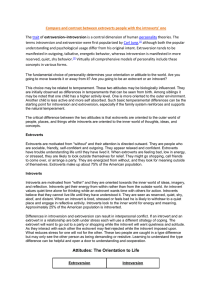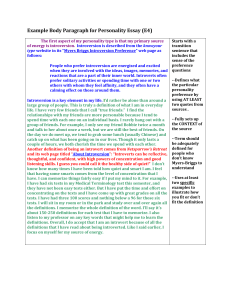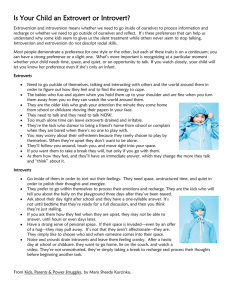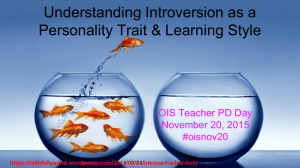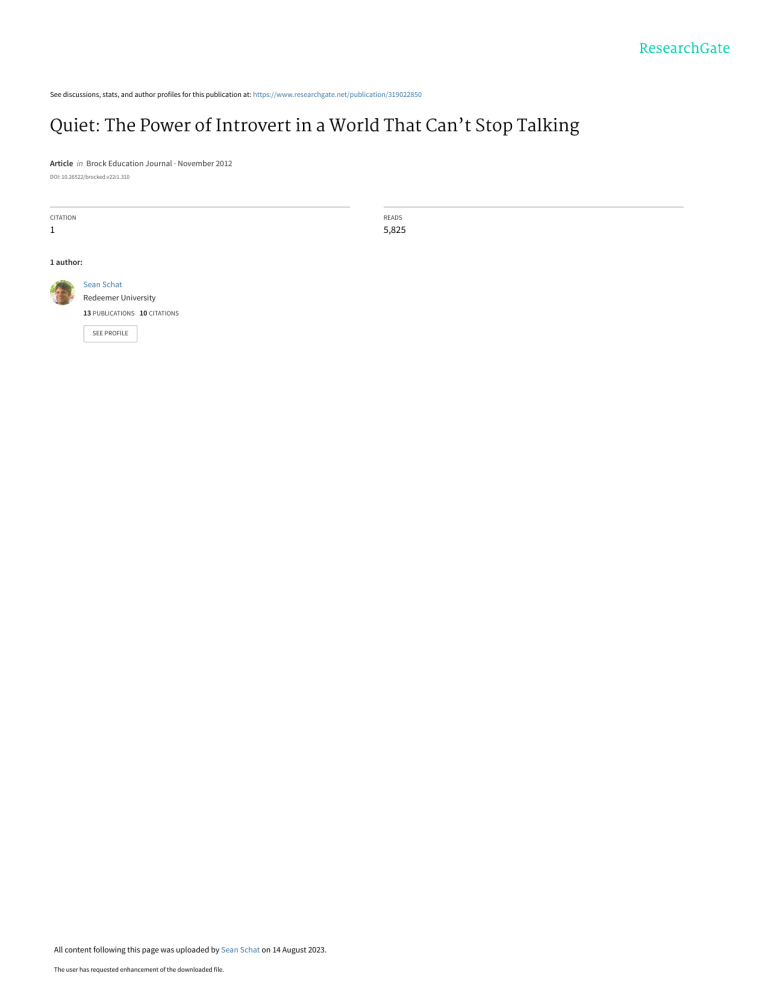
See discussions, stats, and author profiles for this publication at: https://www.researchgate.net/publication/319022850 Quiet: The Power of Introvert in a World That Can’t Stop Talking Article in Brock Education Journal · November 2012 DOI: 10.26522/brocked.v22i1.310 CITATION READS 1 5,825 1 author: Sean Schat Redeemer University 13 PUBLICATIONS 10 CITATIONS SEE PROFILE All content following this page was uploaded by Sean Schat on 14 August 2023. The user has requested enhancement of the downloaded file. BOOK REVIEW Title: Quiet: The Power of Introvert in a World That Can’t Stop Talking Author: Susan Cain Publisher: Crown Publishers Year of Publication: 2012 Reviewed by: Sean Schat, M.Ed. Do you pay attention to the differences between extroversion and introversion? It can be fascinating to consider who is and is not aware of the distinction between the two, as well as the significant formative role they both play in daily perceptions and interactions. In my experience, more often than not it is the introverts who recognize and appreciate the difference, while too many extroverts remain unaware. In Quiet: The Power of Introverts in a World That Can’t Stop Talking (2012), Susan Cain reminds us of the potency and power of the gift of introversion. She challenges her readers to recognize and celebrate the unique insights and contributions that may be latent in communities and organizations—present, but hidden from view, and likely to remain so unless given the space to flourish and to find a voice. She also suggests that creating a space for the introvert voice may bring unforeseen blessings to an organization or community. Despite focusing on introverts, Cain clearly wants to restore a healthier balance between introversion and extroversion in our North American culture. As she points out in her TEDTalks video (Cain, 2012), her husband is an extrovert, as are some of her best friends. Cain values both introversion and extroversion. Her focus, however, is clearly on speaking out for the introverts in our midst. She notes that around one-third to one-half of the population is introverted, and that introverts living in our extrovert-dominated North American culture can easily be overlooked. Cain challenges us to not only value and attend to the introverts in our midst, but to intentionally foster and create the conditions that will allow introverts to thrive and develop; conditions that she suggests will benefit extroverts as well. She also reminds us that there are no “pure” extroverts or introverts, but that the extrovert/introvert distinction is based on a continuum that includes every single one of us. This is a book brimming with insights and references to numerous subtle, important topics that warrant reflective consideration. Many of them may have profound implications for a vast variety of communities and organizations, particularly businesses and schools. Introverts are not necessarily shy people. Drawing heavily on powerful anecdotes and an impressive array of research, Cain notes that introversion is more about one’s response to stimulation, including social stimulation. While extroverts thrive on stimulation, introverts tend to be more stimulus-sensitive, and therefore can be easily over-stimulated. Introverts need time and space to reflect, process, and to consider possible response options. Shyness implies social discomfort, while many introverts simply need alone-time in order to recharge. Cain points out that each person needs a “zone of stimulation” that is right for them, but that many workplaces and schools are not set up this way. Introverts need to stop feeling incomplete. Caine hits this theme in both the book and in her TEDTalks video. In a culture that can often seem extrovert-dominated, introverts can get caught in a pattern of self-negating choices, and assume that there is something wrong with them. They often wish they could and believe they should be more extroverted. The net result is a loss of unique insight, leadership, and creativity. Cain challenges her introverted and extroverted readers to address and confront this powerful misperception. Brock Education Vol 21(1) Fall 2012, 111-114 111 Sean Schat Quiet: The Power of Introvert Introverts perceive differently and may notice what others miss. Because of their innate wiring, introverts are often characterized by heightened sensitivity and an ability to notice subtleties others miss, and they often think in a more elaborate, complex fashion. They pick up on things that other people will not notice, at least not easily. Introverts may need gentle encouragement, however, to point out what they have observed. There is a very real danger that their insights could remain unarticulated. Communities need to create space for the introvert voice. Cain challenges businesses and organizations to create the space for the voice of the introvert, who may perceive things that are critical to organizational success. Their voices are too often overlooked, and they may never find the space to speak, particularly in the business world’s current emphasis on group tasks and organized professional dialogue. The recent emphasis on working in groups or work teams is problematic at a structural level. Similarly, current emphases on open-office or open-classroom concepts may pose unnecessary challenges for introverts and extroverts alike. The problem is not collaboration, but the fact that too often dialogue is structured in such a way that it misses out on the unique insights and contributions of each participant and too easily tends toward “groupthink.” Putting people directly into groups can bypass the critical step of individual reflection, and can easily create a culture driven by dominant voices. The missing voices of the quiet could hold the key to the conversation…and it is quite possible that no one will even hear their words. Cain spends some time in her book exploring the 2007 bank crash in this regard, sharing a number of stories of introverts who “saw it coming.” The Introvert/Extrovert distinction is a global reality. The extroversion/introversion continuum is the one trait that can be measured reliably across the globe. There are distinct differences between cultural groups. Western cultures are often predisposed to extroversion, while Eastern cultures are often more inclined to introversion. Cain reminds us that Western culture tends to be organized around the individual, while Eastern cultures are more focused on the group (be it family, business, or culture community). For those in leadership positions, particularly in business and educational institutions, this is a significant point to keep in mind. Free Trait Theory reminds us that we can choose to overcome our natural tendencies. While people are born with specific personality traits they are naturally inclined toward (extroversion, introversion, etc.), one can act “out of character” in some situations, particularly when there is a perceived need to do so. Cain includes a number of comments from introverted leaders who share examples of occasions where they did not want to speak out, but felt compelled to do so. Ironically, some people may be so accustomed to speaking out of character that others do not even realize how hard it is for them to do so. They are often seen as extroverts, when in fact they are introverts choosing to step out of their natural comfort zones. While not specifically aimed at educators, references to schools and classrooms appear throughout the book’s pages. Quiet has significant educational implications. The key insights from the preceding section will certainly be of value to educators and educational leaders, but I would like to draw specific attention to four education-focused implications. 1. Teachers need to understand the extrovert/introvert distinction, and be able to recognize introversion in their own students. While most teachers tend to have a general awareness of their students’ tendencies, the unique differences between the two ends of the continuum are essential for understanding and connecting with students. Participation could have very different definitions, depending on one’s orientation. Sometimes silent students are actively participating, even if it may not appear to be that case. Teasing quiet introverts for their shyness can backfire. Assuming there is something wrong with them or that they simply need to “grow out of it” is not the answer. Not providing opportunities for the voices of the introvert in group tasks and class discussions can result in significant missed opportunities. As significantly, the differences between introverted students and an Brock Education, 22 (1), Fall 2012, 111-114 112 Sean Schat Quiet: The Power of Introvert extroverted teacher or between extroverted students and an introverted teacher will have a marked impact on relationships and interactions. Knowing the differences is a first step in acting on the blessings the two groups can offer to each other. 2. Students need to be taught about the extrovert/introvert distinction in order to know themselves and understand others. It is important for both introverts and extroverts to know themselves and to appreciate and understand those who are wired differently. There is significant value for individuals to know and understand their own introversion or extroversion, but also to begin to comprehend the significance of the differences between the two. There are neat opportunities to unpack this in a classroom context in a way that will build community and develop skills and insights toward self and others that could transcend the classroom. 3. Educational leaders need to recognize the extroverts and introverts in their school communities, and must factor this into their leadership tasks. It is very important for educational leaders to be aware of the introvert/extrovert distinction in their staff teams and communities. Up to half of the people they work with are introverts, and it is incumbent upon educational leaders to create space and opportunities for the introvert voices to speak their unique insights. Introverted teachers will often see things that others need to hear about, but may not always have an authentic and “safe” forum in which to speak. 4. Educators need to be very aware of the difference between group work and properly structured cooperative learning. Cain raises a legitimate point of concern about the tendency in schools and businesses to lean toward “groupthink” in collaborative dialogue and activities. This pattern runs the risk of missing out completely on the unique insights and contributions of the introverts in their midst. In this reviewer’s opinion, too often teachers do not sufficiently understand and apply the insights of cooperative learning into their planning and structuring of group activities. Cooperative learning draws a careful distinction between individual reflection and group process. When structured properly, individuals are given an opportunity to reflect individually, even if only briefly, prior to working in a group context. When an introvert is presented with this expectation, particularly when they are required to contemplate and prepare to contribute in advance, they are more likely to have something to say. When the teacher also creates the pattern of expectation that each individual HAS something prepared to share, and that all voices need an opportunity to speak, it is much more likely that the unique insights of the introvert will emerge, and the full benefits of cooperative, collaborative interactions will be seen. There is a distinct difference between group work and cooperative learning, and the former, which bears an uncanny resemblance to the groupthink that concerns Cain, does not provide the intentionally structured opportunities for quiet voices to speak. Teachers can take specific actions in order to support the introverted students in their classroom. Redefine participation so that it is no just about talking, but also about active listening, reflection, elaboration, etc. Provide rehearsal/preparation time, so that introverts are able to consider what they might contribute to a small-group or whole-class conversation. Use small groups so that introverts can develop greater comfort levels and confidence. But structure them carefully based on cooperative learning principles. Provide permission NOT to speak in order to reduce anxiety and increase focused participation. Teach all students about personality differences in order to understand both self and others better. Communicate clearly that introversion is not a “problem” to be fixed, but a unique difference to be valued and welcomed. What I appreciated most about Cain was her balanced approach, which comes through clearly in both her writing and her speaking. She is not trumpeting introversion and blasting and bemoaning extroverts and their apparent preferred status in North America. She clearly values and celebrates both ends of the continuum, and recognizes that humanity benefits from this natural diversity. Extroverts and introverts need each other. Cain focuses on reminding us of the difference and its significance. Brock Education, 22 (1), Fall 2012, 111-114 113 Sean Schat Quiet: The Power of Introvert She also encourages her readers to pay more attention to introverts and to the unique challenges they face in their extrovert-inclined cultural contexts. While Quiet is a book that should be widely read, it definitely needs to be read by extroverts who don’t “get” introverts, and by introverts who believe their introversion is a problem or weakness that needs to be “fixed.” The voices of the quiet often wait silently to be heard. And their insights are worth hearing. References Cain, S. (2012, March). Susan Cain: The Power of Introverts [Video File]. Retrieved from www.ted.com/talks/susan_cain_the_power_of_introverts.html Brock Education, 22 (1), Fall 2012, 111-114 114 View publication stats
